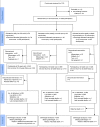The effect of intermittent antenatal iron supplementation on maternal and infant outcomes in rural Viet Nam: a cluster randomised trial
- PMID: 23853552
- PMCID: PMC3708703
- DOI: 10.1371/journal.pmed.1001470
The effect of intermittent antenatal iron supplementation on maternal and infant outcomes in rural Viet Nam: a cluster randomised trial
Abstract
Background: Anemia affects over 500 million women, and in pregnancy is associated with impaired maternal and infant outcomes. Intermittent antenatal iron supplementation is an attractive alternative to daily dosing; however, the impact of this strategy on infant outcomes remains unclear. We compared the effect of intermittent antenatal iron supplementation with daily iron supplementation on maternal and infant outcomes in rural Viet Nam.
Methods and findings: This cluster randomised trial was conducted in Ha Nam province, Viet Nam. 1,258 pregnant women (< 16 wk gestation) in 104 communes were assigned to daily iron-folic acid (IFA), twice weekly IFA, or twice weekly multiple micronutrient (MMN) supplementation. Primary outcome was birth weight. Mean birth weight was 3,148 g (standard deviation 416). There was no difference in the birth weights of infants of women receiving twice weekly IFA compared to daily IFA (mean difference [MD] 28 g; 95% CI -22 to 78), or twice weekly MMN compared to daily IFA (MD -36.8 g; 95% CI -82 to 8.2). At 32 wk gestation, maternal ferritin was lower in women receiving twice weekly IFA compared to daily IFA (geometric mean ratio 0.73; 95% CI 0.67 to 0.80), and in women receiving twice weekly MMN compared to daily IFA (geometric mean ratio 0.62; 95% CI 0.57 to 0.68), but there was no difference in hemoglobin levels. Infants of mothers who received twice weekly IFA had higher cognitive scores at 6 mo of age compared to those who received daily IFA (MD 1.89; 95% CI 0.23 to 3.56).
Conclusions: Twice weekly antenatal IFA or MMN did not produce a clinically important difference in birth weight, when compared to daily IFA supplementation. The significant improvement in infant cognitive outcomes at 6 mo of age following twice weekly antenatal IFA requires further exploration, and provides additional support for the use of intermittent, rather than daily, antenatal IFA in populations with low rates of iron deficiency.
Trial registration: Australia New Zealand Clinical Trials Registry 12610000944033.
Conflict of interest statement
The authors have declared that no competing interests exist.
Figures
References
-
- World Health Organization (2008) Worldwide prevalence of anaemia: 1993–2005: WHO global database on anaemia. Geneva: World Health Organization.
-
- World Health Organization (2001) Iron deficiency anaemia: assessment, prevention and control—a guide for programme managers. Geneva: World Health Organization.
-
- International Anemia Consultative Group Symposium (2002) Report of the 2001 International Anemia Consultative Group Symposium. Why is iron important and what to do about it: a new perspective. Washington (District of Columbia): International Anemia Consultative Group Symposium. 50 p.
-
- World Health Organization (2009) Global health risks: mortality and burden of disease attributable to selected major risks. Geneva: World Health Organization.
-
- Murphy JF, O'Riordan J, Newcombe RG, Coles EC, Pearson JF (1986) Relation of haemoglobin levels in first and second trimesters to outcome of pregnancy. Lancet 1: 992–995. - PubMed
Publication types
MeSH terms
Substances
LinkOut - more resources
Full Text Sources
Other Literature Sources
Medical


